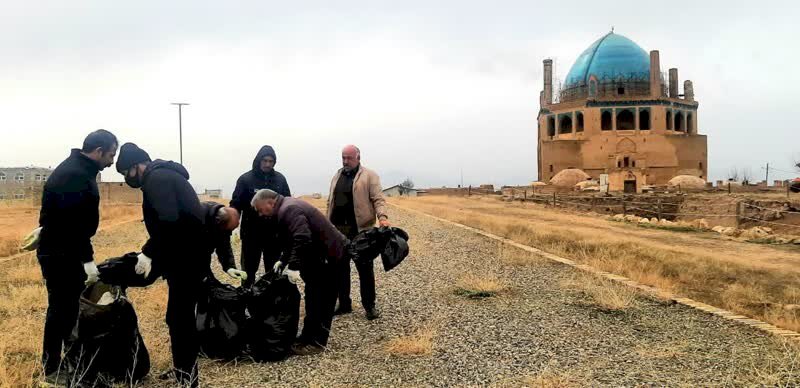Historical properties being cleaned before Iranian new year

TEHRAN – Several cleaning projects have been commenced on various historical sites and tourist destinations across Iran before the Persian new year (Noruz), which officially begins on March 21.
The projects have been held in different cities and sites, including tourist attractions of the ancient town of Rey; near the Iranian capital, Haft-Tappeh and Tchogha Zanbil in Khuzestan province and UNESCO-registered Soltanieh Dome in Zanjan province, CHTN reported on Saturday.
The projects have been carried out in collaboration with non-governmental organizations (NGOs) and cultural heritage aficionados, the report added.
In preparation for Noruz, nationwide Iranians spring-clean every nook and cranny of their homes. The debris is swept away, carpets and curtains are washed, silverware is polished, and windows cleaned to a sparkle. The spring cleaning, known as Khouneh Tekouni in Persian, is preceded by decorating the house with fragrant plants such as daffodils, hyacinths and roses.
Rey was one of the capital cities of the Parthian empire (3rd century BC–3rd century CE) and it was captured by the Muslim Arabs in 641 CE. During the reign of the Muslim caliph al-Mahdi in the 8th century, the city grew in importance until it was rivaled in western Asia only by Damascus and Baghdad.
According to Britannica, Islamic writers described it as a city of extraordinary beauty, built largely of fired brick and brilliantly ornamented with blue faience (glazed earthenware). It continued to be an important city and was briefly a capital under the rule of the Seljuqs, but in the 12th century, it was weakened by the fierce quarrels of rival religious sects. In 1220 the city was almost destroyed by the Mongols, and its inhabitants were massacred. Most of the survivors of the massacre moved to nearby Tehran, and the deserted remnants of Rey soon fell into complete ruin.
Haft-Tappeh (literary meaning “Seven Mounds”) is located 15 kilometers to the south of the ancient city of Susa, itself a highly significant archeological site in southwest Iran.
Early excavations in Haft-Tappeh conducted by the late Iranian archaeologist Dr. Ezzatollah Negahban yielded a large number of petroglyphs bearing cuneiform inscriptions in Akkadian, belonging to Elamite kings. The petroglyphs contain information on religious beliefs, trading methods, and the political, cultural, and social relations of the time.
A topmost tourist destination in Khuzestan province, the magnificent ruins of Tchogha Zanbil (Choghazanbil) are considered by many the finest surviving example of Elamite architecture in the globe. It was made a UNESCO site in 1979. Its construction started in c. 1250 BC upon the order of the Elamite king Untash-Napirisha (1275-1240 BC) as the religious center of Elam dedicated to the Elamite divinities Inshushinak and Napirisha.
UNESCO says that Tchogha Zanbil is the largest ziggurat outside of Mesopotamia and the best preserved of this type of stepped pyramidal monument. Tchogha Zanbil was excavated in six seasons between 1951 and 1961 by Roman Ghirshman, a Russian-born French archeologist who specialized in ancient Iran.
The 14th-century Dome of Soltanieh, which supports the third-largest brick dome in the world, is also famed as the Mausoleum of Oljaytu and is highly recognized as an architectural masterpiece, particularly due to its innovative double-shelled dome and elaborate interior decoration. The very imposing dome stands about 50 meters tall from its base. A great-grandson of Hulegu, founder of the Il-Khanid dynasty, Oljaytu was a Mongol ruler who, after dabbling in various religions, adopted the Shia name Mohammed Khodabandeh.
Soltanieh’s decoration is such impressive that scholars, including A.U. Pope, described it as ‘anticipating the Taj Mahal.’ It is the earliest existing example of a double-shelled dome in Iran.
ABU/AM
Leave a Comment